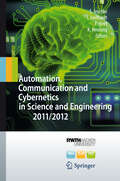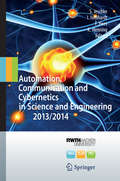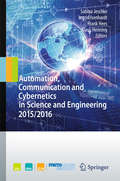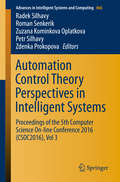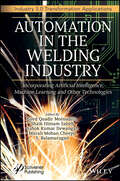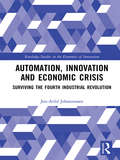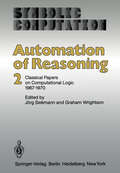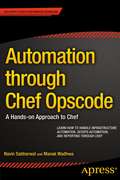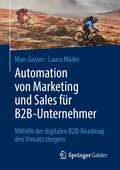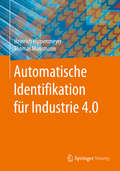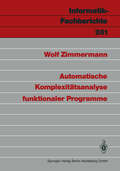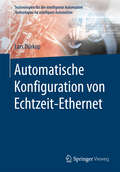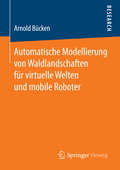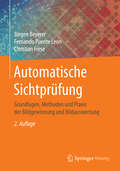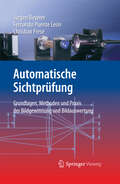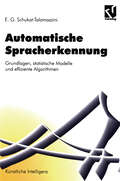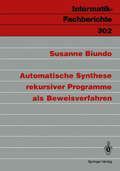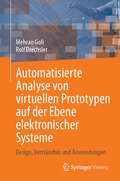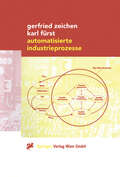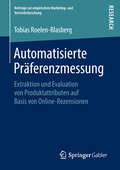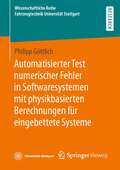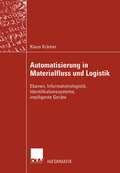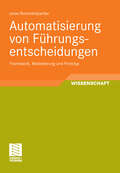- Table View
- List View
Automation, Communication and Cybernetics in Science and Engineering 2011/2012
by Sabina Jeschke Ingrid Isenhardt Frank Hees Klaus HenningThe book is the follow-up to its predecessor “Automation, Communication and Cybernetics in Science and Engineering 2009/2010” and includes a representative selection of all scientific publications published between 07/2011 and 06/2012 in various books, journals and conference proceedings by the researchers of the following institute cluster:IMA - Institute of Information Management in Mechanical EngineeringZLW - Center for Learning and Knowledge ManagementIfU - Associated Institute for Management CyberneticsFaculty of Mechanical Engineering, RWTH Aachen UniversityInnovative fields of application, such as cognitive systems, autonomous truck convoys, telemedicine, ontology engineering, knowledge and information management, learning models and technologies, organizational development and management cybernetics are presented.
Automation, Communication and Cybernetics in Science and Engineering 2013/2014
by Sabina Jeschke Ingrid Isenhardt Frank Hees Klaus HenningThis book continues the tradition of its predecessors “Automation, Communication and Cybernetics in Science and Engineering 2009/2010 and 2011/2012” and includes a representative selection of scientific publications from researchers at the institute cluster IMA/ZLW & IfU. IMA - Institute of Information Management in Mechanical Engineering ZLW - Center for Learning and Knowledge Management IfU - Associated Institute for Management Cybernetics e.V. Faculty of Mechanical Engineering, RWTH Aachen University The book presents a range of innovative fields of application, including: cognitive systems, cyber-physical production systems, robotics, automation technology, machine learning, natural language processing, data mining, predictive data analytics, visual analytics, innovation and diversity management, demographic models, virtual and remote laboratories, virtual and augmented realities, multimedia learning environments, organizational development and management cybernetics. The contributions selected reflect the fundamental paradigm shift toward an increasingly interdisciplinary research world – which has always been both the basis and spirit of the institute cluster IMA/ZLW & IfU.
Automation, Communication and Cybernetics in Science and Engineering 2015/2016
by Sabina Jeschke Ingrid Isenhardt Frank Hees Klaus HenningAutomation, Communication and Cybernetics in Science and Engineering
Automation Control Theory Perspectives in Intelligent Systems: Proceedings of the 5th Computer Science On-line Conference 2016 (CSOC2016), Vol 3 (Advances in Intelligent Systems and Computing #466)
by Radek Silhavy Roman Senkerik Zuzana Kominkova Oplatkova Petr Silhavy Zdenka ProkopovaThe volume Automation Control Theory Perspectives in Intelligent Systems presents new approaches and methods to real-world problems, and in particular, exploratory research that describes novel approaches in the field of cybernetics and automation control theory. Particular emphasis is laid on modern trends in intelligent information technology, system monitoring and proactive management of complex objects The 5th Computer Science On-line Conference (CSOC2016) is intended to provide an international forum for discussions on the latest high-quality research results in all areas related to Computer Science. The addressed topics are the theoretical aspects and applications of Computer Science, Artificial Intelligences, Cybernetics, Automation Control Theory and Software Engineering.
Automation in the Welding Industry: Incorporating Artificial Intelligence, Machine Learning and Other Technologies (Industry 5.0 Transformation Applications)
by Syed Quadir Moinuddin Shaik Himam Saheb Ashok Kumar Dewangan Murali Mohan Cheepu S. BalamuruganAUTOMATION IN THE WELDING INDUSTRY This volume serves as a multidimensional perspective of welding practices in Industry 5.0 from the perspective of automation, digitization, digital twins, cobots, virtual reality, augmented reality, machine learning, artificial intelligence, and IoT ranging from rudiments to advanced applications. This book introduces the concept of Industry 5.0 in welding technologies, where the human brain collaborates with robots to achieve rapid productivity and economic efficiency. It presents the latest information on adapting and integrating Industry 5.0 in welding industries through critical constituents such as artificial intelligence (AI), machine learning (ML), Internet of Things (IoT), digital twin, augmented and virtual reality (AR & VR), and collaborative robots (Cobots), towards intelligent welding systems. The chapter authors have comprehensively addressed the issues related to welding industries such as a shortage of welders, challenges in critical applications, creating defect-free and quality products through real-time monitoring, feedback systems, and in situ adjustments, etc. The utilization of cobots in welding technology is addressed in real-world problems to move towards a green welding environment (i.e., minimal fumes with less shielding gas) and thereby, less energy consumption. Two or more welding processes are combined to form a hybrid process where the compatibility of existing materials and novel materials can be used in 3D, 4D, and 5D printing of complex geometries. Audience Engineering research scholars, industry welding, and additive manufacturing groups. A diverse group of industries will be interested in this book, such as medical, automotive, construction, pipeline, shipping, aerospace, etc.
Automation in the Welding Industry: Incorporating Artificial Intelligence, Machine Learning and Other Technologies (Industry 5.0 Transformation Applications)
by Syed Quadir Moinuddin Shaik Himam Saheb Ashok Kumar Dewangan Murali Mohan Cheepu S. BalamuruganAUTOMATION IN THE WELDING INDUSTRY This volume serves as a multidimensional perspective of welding practices in Industry 5.0 from the perspective of automation, digitization, digital twins, cobots, virtual reality, augmented reality, machine learning, artificial intelligence, and IoT ranging from rudiments to advanced applications. This book introduces the concept of Industry 5.0 in welding technologies, where the human brain collaborates with robots to achieve rapid productivity and economic efficiency. It presents the latest information on adapting and integrating Industry 5.0 in welding industries through critical constituents such as artificial intelligence (AI), machine learning (ML), Internet of Things (IoT), digital twin, augmented and virtual reality (AR & VR), and collaborative robots (Cobots), towards intelligent welding systems. The chapter authors have comprehensively addressed the issues related to welding industries such as a shortage of welders, challenges in critical applications, creating defect-free and quality products through real-time monitoring, feedback systems, and in situ adjustments, etc. The utilization of cobots in welding technology is addressed in real-world problems to move towards a green welding environment (i.e., minimal fumes with less shielding gas) and thereby, less energy consumption. Two or more welding processes are combined to form a hybrid process where the compatibility of existing materials and novel materials can be used in 3D, 4D, and 5D printing of complex geometries. Audience Engineering research scholars, industry welding, and additive manufacturing groups. A diverse group of industries will be interested in this book, such as medical, automotive, construction, pipeline, shipping, aerospace, etc.
Automation, Innovation and Economic Crisis: Surviving the Fourth Industrial Revolution (Routledge Studies in the Economics of Innovation)
by Jon-Arild JohannessenThe fourth industrial revolution is developing globally, with no geographical centre. It is also taking place at enormous speed. This development will shape the workplaces of the future, which will be entirely different from the workplaces created by the first, second and third industrial revolutions. Industry created the industrial worker. The knowledge society will create a new type of "industrial worker", the knowledge worker. While the third industrial revolution was concerned with the digitalization of work, in the fourth industrial revolution, robots will bring about the informatization of work. Many of these robots will be systematically connected, such that they can obtain updated information and learn from their own and others’ mistakes. The way we work, where we work, what we work on, and our relationships with our colleagues and employers are all in a state of change. The workplace of the future will not necessarily be a fixed geographical location, but may be geographically distributed and functionally divided. In his book, Jon-Arild Johannessen argues that a "perfect" social storm occurs when inequality grows at a catastrophic rate, unemployment increases, job security is threatened for a growing number and robotization takes over even the most underpaid jobs. Thus, the ingredients for a perfect social storm will be brought forward by cascades of innovations that will most likely lead to economic and social crises and he argues that it is reasonable to assume that it will only take a small spark for this social storm to develop into a social revolution.
Automation, Innovation and Economic Crisis: Surviving the Fourth Industrial Revolution (Routledge Studies in the Economics of Innovation)
by Jon-Arild JohannessenThe fourth industrial revolution is developing globally, with no geographical centre. It is also taking place at enormous speed. This development will shape the workplaces of the future, which will be entirely different from the workplaces created by the first, second and third industrial revolutions. Industry created the industrial worker. The knowledge society will create a new type of "industrial worker", the knowledge worker. While the third industrial revolution was concerned with the digitalization of work, in the fourth industrial revolution, robots will bring about the informatization of work. Many of these robots will be systematically connected, such that they can obtain updated information and learn from their own and others’ mistakes. The way we work, where we work, what we work on, and our relationships with our colleagues and employers are all in a state of change. The workplace of the future will not necessarily be a fixed geographical location, but may be geographically distributed and functionally divided. In his book, Jon-Arild Johannessen argues that a "perfect" social storm occurs when inequality grows at a catastrophic rate, unemployment increases, job security is threatened for a growing number and robotization takes over even the most underpaid jobs. Thus, the ingredients for a perfect social storm will be brought forward by cascades of innovations that will most likely lead to economic and social crises and he argues that it is reasonable to assume that it will only take a small spark for this social storm to develop into a social revolution.
Automation of Reasoning: 2: Classical Papers on Computational Logic 1967–1970 (Symbolic Computation)
by J. Siekmann G. Wrightson"Kind of crude, but it works, boy, it works!" AZan NeweZZ to Herb Simon, Christmas 1955 In 1954 a computer program produced what appears to be the first computer generated mathematical proof: Written by M. Davis at the Institute of Advanced Studies, USA, it proved a number theoretic theorem in Presburger Arithmetic. Christmas 1955 heralded a computer program which generated the first proofs of some propositions of Principia Mathematica, developed by A. Newell, J. Shaw, and H. Simon at RAND Corporation, USA. In Sweden, H. Prawitz, D. Prawitz, and N. Voghera produced the first general program for the full first order predicate calculus to prove mathematical theorems; their computer proofs were obtained around 1957 and 1958, about the same time that H. Gelernter finished a computer program to prove simple high school geometry theorems. Since the field of computational logic (or automated theorem proving) is emerging from the ivory tower of academic research into real world applications, asserting also a definite place in many university curricula, we feel the time has corne to examine and evaluate its history. The article by Martin Davis in the first of this series of volumes traces the most influential ideas back to the 'prehistory' of early logical thought showing how these ideas influenced the underlying concepts of most early automatic theorem proving programs.
Automation through Chef Opscode: A Hands-on Approach to Chef
by Navin Sabharwal Manak WadhwaAutomation through Chef Opscode provides an in-depth understanding of Chef, which is written in Ruby and Erlang for configuration management, cloud infrastructure management, system administration, and network management. Targeted at administrators, consultants, and architect, the book guides them through the advanced features of the tool which are necessary for infrastructure automation, devops automation, and reporting. The book presumes knowledge of Ruby and Erlang which are used as reference languages for creating recipes and cookbooks and as a refresher on them to help the reader get on speed with the flow of book. The book provides step by step instructions on installation and configuration of Chef, usage scenarios of Chef, in infrastructure automation by providing common scenarios like virtual machine provisioning, OS configuration for Windows, Linux, and Unix, provisioning and configuration of web servers like Apache along with popular databases like MySQL. It further elaborates on the creation of recipes, and cookbooks, which help in deployment of servers and applications to any physical, virtual, or cloud location, no matter the size of the infrastructure. The books covers advanced features like LWRPs and Knife and also contains several illustrative sample cookbooks on MySQL, Apache, and CouchDB deployment using a step by step approach.
Automation von Marketing und Sales für B2B-Unternehmer: Mithilfe der digitalen B2B-Roadmap den Umsatz steigern
by Marc Gasser Laura MäderDie Automation von Marketing und Sales ist in Zukunft erfolgsentscheidend. Nur so können B2B-Unternehmen dem Wettbewerbsdruck weiterhin standhalten. Doch der Aufbau eines digitalen Marketing- und Salesprozesses ist aufwendig und komplex und stellt insbesondere kleinere B2B-Unternehmen vor die herausfordernde Frage: Wie kann die Digitalisierung möglichst kosteneffizient vorangetrieben werden? Anhand von Erfahrungswerten aus über 100 B2B-Digitalisierungsprojekten haben Laura Mäder und Marc Gasser das Modell der digitalen B2B-Roadmap entwickelt – eine Schritt-für-Schritt-Anleitung für die Planung, Steuerung und Skalierung von digitalem Marketing und Sales. Mithilfe der digitalen B2B-Roadmap Leads automatisiert entlang der Customer-Journey führen, einen Wettbewerbsvorteil erreichen und den Umsatz steigern. Dieses Buch ist für B2B-Unternehmer, Visionäre und Impulsgeber, die veraltete Marketing- und Salesmodelle auf den Kopf stellen und Innovation effizient vorantreiben wollen.
Automatische Identifikation für Industrie 4.0
by Heinrich Hippenmeyer Thomas MoosmannDie Autoren gehen in diesem Buch darauf ein, welche Herausforderungen mit "Industrie 4.0" auf Industriepraktiker zukommen. Wie und mit welchen Zielsetzungen können Entwicklungen in mittelständischen Unternehmen aufgegriffen werden? Die Geräte zur automatischen Identifikation als Teil der Prozesssteuerung und Systemplanung der Intralogistik, zur Einbindung in das Netzwerk im Unternehmen und mit Partnern, sind Kumulationspunkte vieler Probleme in kleinen und mittelständischen Unternehmen. Diesen wird dargelegt wo und wie in den automatisierten Unternehmensbereichen Schritte zur "digitalen" Fabrik bereits vollzogen wurden und wie die Einbindung der betrieblichen Intralogistik in das firmenweite Netzwerk und damit in das ERP-System erfolgen kann.
Automatische Komplexitätsanalyse funktionaler Programme (Informatik-Fachberichte #261)
by Wolf ZimmermannEs gibt im Bereich der Softwaretechnik viele Werkzeuge, die den Programmentwicklungsprozeß unterstützen. Sie stellen die Korrektheit der Implementierung sicher, nicht aber ihre Effizienz. Die vorliegende Arbeit führt daher eine Methode ein, die es erlaubt, die Zeitkomplexität funktionaler Programme automatisch zu ermitteln. Die Grundidee dieser Methode besteht darin, ein funktionales Programm in ein System von Rekurrenzgleichungen zu übersetzen, dessen Lösung das Zeitverhalten des Programms angibt. Durch Einführung von bedingten Rekurrenzen und Rekurrenzfamilien ist es möglich, obere und untere Schranken für die Zeitkomplexität zu finden. Um die mittlere Zeitkomplexität zu bestimmen, müssen Wahrscheinlichkeiten dafür berechnet werden, daß im Programm vorkommende Bedingungen wahr bzw. falsch werden. Diese Wahrscheinlichkeiten werden anhand einer probabilistischen Semantik des Programms berechnet. Um möglichst genaue Schranken für die Zeitkomplexität zu erhalten, muß eine Abhängigkeitsanalyse durchgeführt werden. Dies ermöglicht eine genaue Analyse von Divide-and-Conquer-Programmen.
Automatische Konfiguration von Echtzeit-Ethernet (Technologien für die intelligente Automation)
by Lars DürkopDas in diesem Buch vorgestellte Konzept schließt eine Lücke im Forschungsstand zum Bereich prozessnaher Echtzeitkommunikation für rekonfigurierbare Produktionssysteme. Aktuelle in der Automatisierungstechnik eingesetzte Echtzeitzeitnetzwerke zeichnen sich durch hohe Konfigurationsaufwände aus, welche bei der Inbetriebnahme und nach jeder Rekonfiguration anfallen. Für die Realisierung „Plug and Produce“-fähiger Anwendungen ist es notwendig, diese Aufwände möglichst zu reduzieren. Hierzu wird in diesem Buch die Entwicklung eines Verfahrens zur automatischen Konfiguration aktueller in der Automatisierungstechnik eingesetzter Echtzeitnetzwerke beschrieben.Konkret werden die Echtzeit-Netzwerke Profinet, Ethernet/IP, Ethernet Powerlink und Ethercat betrachtet. Für diese Netzwerke wird zuerst untersucht, welche Informationen für eine Inbetriebnahme notwendig sind. Darauf aufbauend wird das Konzept zur automatischen Konfiguration entwickelt. Anhand einer Probandenstudie wird exemplarisch für Profinet gezeigt, inwiefern der Inbetriebnahme-Aufwand durch die automatische Konfiguration reduziert werden kann.
Automatische Modellierung von Waldlandschaften für virtuelle Welten und mobile Roboter
by Arnold BückenFernerkundungsdaten wie Luftbilder, Gelände- und Oberflächenmodelle sind inzwischen global verfügbar und haben ihren Platz in unserem Alltag gefunden. Andererseits werden Landschaftsmodelle für Simulationen und Darstellungen in der Virtuellen Realität in vielen Fällen weiterhin aufwendig von Hand generiert. Arnold Bücken zeigt einen Weg auf, wie sich Waldlandschaften in einem automatisierten Verfahren großflächig aus Fernerkundungsdaten ableiten lassen. Das Ergebnis sind detaillierte Waldmodelle mit geografisch verorteten, attribuierten Einzelbäumen, die sich für eine Vielzahl von Simulationsaufgaben eignen und gleichzeitig eine hochdetaillierte kartografische Aufnahme des Waldes, beispielsweise für Lokalisierungsaufgaben von robotischen Systemen, bieten.
Automatische Sichtprüfung: Grundlagen, Methoden und Praxis der Bildgewinnung und Bildauswertung
by Jürgen Beyerer Fernando Puente León Christian FreseDas Lehrbuch behandelt systematisch die Bildgewinnung für die automatische Sichtprüfung. Die Autoren leiten die wesentlichen Methoden detailliert ab und stellen alle gängigen Bildgewinnungsverfahren in einem strukturierten Zusammenhang dar.Der zweite Teil des Buches ist der Bildsignalbeschreibung und der Bildauswertung gewidmet, wobei insbesondere Methoden behandelt werden, die für die automatische Sichtprüfung relevant sind.Die Autoren skizzieren die Herleitung der beschriebenen Methoden, ohne sich in mathematischen Details zu verlieren. Ihr Ziel ist, dass der Leser die Zusammenhänge wirklich versteht und das "große Bild" des Fachgebietes erkennt. Das Buch ist in sich geschlossen und bedarf zum Verständnis keiner ergänzenden Literatur. Die 2. Auflage wurde gründlich überarbeitet, inhaltlich ergänzt und aktualisiert. Neue Beispiele verdeutlichen den Bezug zur Praxis.Die ZielgruppenDas Buch eignet sich für Studierende der Informatik, Elektro- und Informationstechnik, der Physik und des Maschinenbaus. Ebenso wendet es sich an Ingenieure in der Automatisierungstechnik.
Automatische Sichtprüfung: Grundlagen, Methoden und Praxis der Bildgewinnung und Bildauswertung
by Jürgen Beyerer Fernando Puente León Christian FreseIn diesem ersten Lehrbuch mit dem Schwerpunkt Bildgewinnung und automatische Sichtprüfung stellen die Autoren alle gängigen Bildgewinnungsverfahren systematisch dar und leiten die wesentlichen Methoden detailliert ab. Der zweite Teil ist der Bildsignalbeschreibung und -auswertung gewidmet, insbesondere den Methoden, die für die automatische Sichtprüfung relevant sind. Das Buch ist für Studierende der Informatik, Elektro- und Informationstechnik, der Physik und des Maschinenbaus ebenso geeignet wie für Ingenieure in der Automatisierungstechnik.
Automatische Spracherkennung: Grundlagen, statistische Modelle und effiziente Algorithmen (Artificial Intelligence)
by Ernst Günter Schukat-TalamazziniAutomatische Synthese rekursiver Programme als Beweisverfahren (Informatik-Fachberichte #302)
by Susanne BiundoAutomatisierte Analyse von virtuellen Prototypen auf der Ebene elektronischer Systeme: Design, Verständnis und Anwendungen
by Mehran Goli Rolf DrechslerDieses Buch beschreibt eine Reihe von SystemC-basierten Analysemethoden für virtuelle Prototypen, einschließlich Entwurfsverständnis, Verifikation, Sicherheitsvalidierung und Entwurfsraumuntersuchung. Der Leser erhält einen Überblick über die neuesten Forschungsergebnisse auf dem Gebiet der Electronic Design Automation (EDA) auf der elektronischen Systemebene (ESL). Die besprochenen Methoden ermöglichen es den Lesern, wichtige Aufgaben und Anwendungen im Entwurfsprozess leicht zu bewältigen.Übersetzt mit www.DeepL.com/Translator (kostenlose Version)
Automatisierte Industrieprozesse
by Gerfried Zeichen Karl FürstDie ganzheitliche Behandlung von komplexen industriellen Prozessen in der Produkt- und Prozessentwicklung und bei der Herstellung von Sachgütern und/oder Dienstleistungen ist das zentrale Thema des Buches. Die Autoren haben eine völlig neue Darstellung in der Form von Thesen gewählt, die aus Erfahrungen bei der Planung und Durchführung von komplexen Industrieprozessen destilliert wurden. Auf folgende Punkte wurde besonderer Wert gelegt: • Vernetzung von rein technischen mit den organisatorischen und betriebswirtschaftlichen Prozessen • Lösungen zur Quantifizierung schwer quantifizierbarer Parameter in industriellen Prozessen • Strenge Orientierung für Vorgehensweisen nach dem Prinzip Erkennen –> Erfassen –> Agieren –> Entscheiden • Ganzheitliche Betrachtung der Informationsprozesse innerhalb eines Betriebes und Behandlung der dafür verfügbaren Informationswerkzeuge
Automatisierte Präferenzmessung: Extraktion und Evaluation von Produktattributen auf Basis von Online-Rezensionen (Beiträge zur empirischen Marketing- und Vertriebsforschung)
by Tobias Roelen-BlasbergTobias Roelen-Blasberg stellt in diesem Buch einen neuen Ansatz zur automatisierten Präferenzmessung vor. Anhand verschiedener Methoden aus den Bereichen Natural Language Processing, Text Mining und Machine Learning extrahiert der automatisierte Ansatz Produktattribute aus nutzergenerierten, textuellen Daten und bewertet diese hinsichtlich ihrer Stimmung. Anschließend validiert der Autor die automatisierten Ergebnisse mit klassischen Marktforschungsmethoden wie z. B. mit einer Conjoint Analyse. Die Ergebnisse der Studien zeigen, dass sich anhand des neuen Ansatzes relevante Produktattribute automatisiert extrahieren lassen, wobei sich die Attributwichtigkeiten im Vergleich zu klassischen Präferenzmessungen unterscheiden können.
Automatisierter Test numerischer Fehler in Softwaresystemen mit physikbasierten Berechnungen für eingebettete Systeme (Wissenschaftliche Reihe Fahrzeugtechnik Universität Stuttgart)
by Philipp GöttlichPhilipp Göttlich stellt ein Konzept zum automatisierten Testen von numerischen Fehlern in Softwaresystemen mit physikbasierten Berechnungen vor und gibt dabei einen weitreichenden Überblick der Arten und Auswirkungen numerischer Fehler. Die wesentlichen Neuerungen des Konzepts spiegeln sich in der optimierungsbasierten Erzeugung geeigneter Testsignale und den Back-to-Back Tests einzelner Entwicklungsartefakte zur präzisen Fehlerlokalisierung wider. Am Beispiel von drei Softwaresystemen eines aktuellen Forschungsprojektes und dem Vergleich mit Referenztests wird die hohe Effizienz des Ansatzes bei der Analyse nachgewiesen. Auch die Erweiterbarkeit des Ansatzes wird im Verlauf der Arbeit demonstriert und dient als Ausgangspunkt für weitere Studien.
Automatisierung in Materialfluss und Logistik: Ebenen, Informationslogistik, Identifikationssysteme, intelligente Geräte
by Klaus KrämerKlaus Krämer präsentiert eine systematische und ganzheitliche Darstellung der Automatisierungstechnik im Rahmen von Materialfluss und Logistik aus der Sicht der Information. Im Mittelpunkt stehen der Einsatz von Identifika-tionstechniken, das Verknüpfen von Daten über verschiedene Ebenen im System, die Logistik der Information und die Anbindung von Geräten über Bussysteme an übergeordnete Stellen.
Automatisierung von Führungsentscheidungen: Framework, Modellierung und Prototyp (Entwicklung und Management von Informationssystemen und intelligenter Datenauswertung)
by Jonas RommelspacherJonas Rommelspacher untersucht, ob Führungskräfte durch die Automatisierung ausgewählter Entscheidungen entlastet werden können. Er erarbeitet die Merkmale von Führungsentscheidungen und entwickelt ein Konzept, welches mithilfe von hierarchisch organisierten Entscheidungsprogrammen ausgewählte Führungsentscheidungen automatisieren kann.
